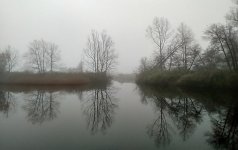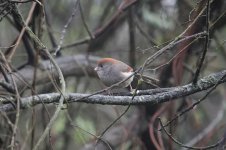
With tickets to a concert in Milan dictating the timing and the season being decidedly not optimal for Alpine butterflies nor for birding in general, I scratched my head a little for what to do in Italy for a few days. And then an idea appeared - an attempt to see all of the established exotics in northern Italy, this virtually guaranteeing me some new birds, something rare in Europe these days.
So it was, with the lure of Vinous-throated Parrotbills and Red-billed Leiothrix rather tempting, a short itinerary evolved basically covering the Milan to Pisa areas. The following non-native species have established themselves in the region:
29 March. Arrival in Milan.
Early evening flight from Lithuania, touched down in Milan at 7.30 pm local time. Already dark, nothing to see. Picked up a rental car, drove an hour or so west to the Varese area.
30 March. Palude Brabbia, Arnetta, Parco Castella.
Deep damp gloom of the predawn plains west of Milan, Black Redstarts singing in the darkness. I drove a dozen kilometres to reach the Palude Brabbia wetlands way too early, the leaden skies and heavy mist further obscuring any hints of the day to come. Yet already a positive feast of bird song, Blackcaps and Redwings in particular abundant voice.
As light finally crept in, I wandered down towards the edge of the Palude Brabbia marshland, my quest for parrotbills could commence. My first chosen point was a narrow track pushing out into the marsh, heavily flanked by dense shrubbery and bushes …perfect to my eye for parrotbills. Not sure the parrotbills had the same opinion, or perhaps they didn't like the damp conditions - plenty of common birds, but not a peep or call of anything remotely suggesting parrotbill in the first hour. Things then changed - alerted by the chattering call, a pair of parrotbills did indeed appear - Ashy-throated Parrotbills. Cute little things, but highly active and unexpectedly secretive - a few relatively brief views and off they went. Tried in vain to relocate them and subsequent searching did not reveal any further birds. Deciding to move three kilometres further along, I then tried my luck along the ‘sentiero natura’. Wet and boggy underfoot, but pretty good general birding - alongside Great Spotted Woodpeckers and rather plentiful Green Woodpeckers, also bumped into both Black Woodpeckers and Lesser Spotted Woodpecker. Still heavily overcast with mist sitting over the marsh, Marsh Harriers and Black Kites looked bedraggled, while waterbirds amounted to murky shapes off yonder, most being Little Grebes and Mallards. As for parrotbills, I had walked about three kilometres before finally encountering them - first a pair of Vinous-throated Parrotbills in a clump of semi-flooded willows that frustratingly did a vanishing act almost the same as the earlier birds, then final success with a large mixed flock of the two species that proceeded to feed in bushes and rank vegetation for about 15-20 minutes right alongside the boardwalk …superb, a minimum of three Vinous-throated Parrotbills and eight Ashy-throated Parrotbills.
With these successfully seen, I walked up through the village, Italian Sparrows and Serins prominent, before returning to accommodation for mid-morning breakfast.
With the concert set for Milan this evening, I then shifted south a little to new accommodation just south of Malpensa airport - easy striking distance for the concert and, more importantly, very close to a Northern Bobwhite area, the plan to target these birds the following morning. With the afternoon still free, I decided to have a wander around the Arnetta wetlands - two sets of artificial pools a handful of kilometres apart. And quite superb they were - the northern set sporting no less than 40 splendid Ferruginous Ducks and five Red-crested Pochards, as well as a Purple Heron and six Night Herons, while the southern set boasted even more waterbirds in general, but mostly Shoveler (140+), Gadwall (35) and Common Pochard (120+). Notching up the third non-native of the day, albeit not one I was exactly targeting, several Mute Swans at both sets of pools too.
Time to head to Milan, but still time for a short twitch to one of the city's parks - Parco Castello. Among a motley crew of various pinioned collection birds (Bar-headed Goose, Redbreasted Goose, Ruddy Shelduck, Wood Duck, etc), the park’s pool were also attracting one further established exotic - Mandarin Duck. Took quite a while to find them, and was interrupted by my first Ring-necked Parakeets of the trip, but eventually found a pair of Mandarins quietly feeding at the rear of one pool. Continuing the alien theme, umpteen Grey Squirrels here too.
So that was birding for the day over - five Category C species seen. Headed into Milan for the concert.
So it was, with the lure of Vinous-throated Parrotbills and Red-billed Leiothrix rather tempting, a short itinerary evolved basically covering the Milan to Pisa areas. The following non-native species have established themselves in the region:
- Northern Bobwhite *
- Mute Swan
- Mandarin Duck
- Sacred Ibis *
- Ring-necked Parakeet
- Monk Parakeet
- Vinous-throated Parrotbill *
- Ashy-throated Parrotbill *
- Red-billed Leiothrix *
29 March. Arrival in Milan.
Early evening flight from Lithuania, touched down in Milan at 7.30 pm local time. Already dark, nothing to see. Picked up a rental car, drove an hour or so west to the Varese area.
30 March. Palude Brabbia, Arnetta, Parco Castella.
Deep damp gloom of the predawn plains west of Milan, Black Redstarts singing in the darkness. I drove a dozen kilometres to reach the Palude Brabbia wetlands way too early, the leaden skies and heavy mist further obscuring any hints of the day to come. Yet already a positive feast of bird song, Blackcaps and Redwings in particular abundant voice.
As light finally crept in, I wandered down towards the edge of the Palude Brabbia marshland, my quest for parrotbills could commence. My first chosen point was a narrow track pushing out into the marsh, heavily flanked by dense shrubbery and bushes …perfect to my eye for parrotbills. Not sure the parrotbills had the same opinion, or perhaps they didn't like the damp conditions - plenty of common birds, but not a peep or call of anything remotely suggesting parrotbill in the first hour. Things then changed - alerted by the chattering call, a pair of parrotbills did indeed appear - Ashy-throated Parrotbills. Cute little things, but highly active and unexpectedly secretive - a few relatively brief views and off they went. Tried in vain to relocate them and subsequent searching did not reveal any further birds. Deciding to move three kilometres further along, I then tried my luck along the ‘sentiero natura’. Wet and boggy underfoot, but pretty good general birding - alongside Great Spotted Woodpeckers and rather plentiful Green Woodpeckers, also bumped into both Black Woodpeckers and Lesser Spotted Woodpecker. Still heavily overcast with mist sitting over the marsh, Marsh Harriers and Black Kites looked bedraggled, while waterbirds amounted to murky shapes off yonder, most being Little Grebes and Mallards. As for parrotbills, I had walked about three kilometres before finally encountering them - first a pair of Vinous-throated Parrotbills in a clump of semi-flooded willows that frustratingly did a vanishing act almost the same as the earlier birds, then final success with a large mixed flock of the two species that proceeded to feed in bushes and rank vegetation for about 15-20 minutes right alongside the boardwalk …superb, a minimum of three Vinous-throated Parrotbills and eight Ashy-throated Parrotbills.
With these successfully seen, I walked up through the village, Italian Sparrows and Serins prominent, before returning to accommodation for mid-morning breakfast.
With the concert set for Milan this evening, I then shifted south a little to new accommodation just south of Malpensa airport - easy striking distance for the concert and, more importantly, very close to a Northern Bobwhite area, the plan to target these birds the following morning. With the afternoon still free, I decided to have a wander around the Arnetta wetlands - two sets of artificial pools a handful of kilometres apart. And quite superb they were - the northern set sporting no less than 40 splendid Ferruginous Ducks and five Red-crested Pochards, as well as a Purple Heron and six Night Herons, while the southern set boasted even more waterbirds in general, but mostly Shoveler (140+), Gadwall (35) and Common Pochard (120+). Notching up the third non-native of the day, albeit not one I was exactly targeting, several Mute Swans at both sets of pools too.
Time to head to Milan, but still time for a short twitch to one of the city's parks - Parco Castello. Among a motley crew of various pinioned collection birds (Bar-headed Goose, Redbreasted Goose, Ruddy Shelduck, Wood Duck, etc), the park’s pool were also attracting one further established exotic - Mandarin Duck. Took quite a while to find them, and was interrupted by my first Ring-necked Parakeets of the trip, but eventually found a pair of Mandarins quietly feeding at the rear of one pool. Continuing the alien theme, umpteen Grey Squirrels here too.
So that was birding for the day over - five Category C species seen. Headed into Milan for the concert.








